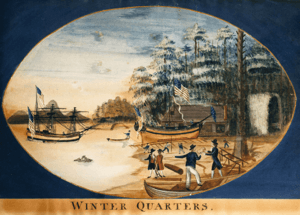Adventure (1792 ship) facts for kids

Launch of the Adventure with Fort Defiance and Columbia in background. Painting by George Davidson, who served as an artist on the Columbia
|
|
Quick facts for kids History |
|
|---|---|
| Name | Adventure |
| Laid down | 1791 |
| Launched |
|
| Fate | Sold to Spain |
| Notes | First US ship built in the Pacific NW |
| Name | Orcacitas |
| Acquired | 1792 |
| General characteristics | |
| Class and type | sloop |
| Tons burthen | 45 (bm) |
| Length | 50 ft (15 m) |
| Propulsion | sail |
| Complement | 12 |
The Adventure was a small sailing ship built in 1792. It was special because it was the first American ship ever built on the Pacific Northwest coast of North America. Captain Robert Gray's crew built it during their journey to trade for animal furs. The Adventure was a sloop, which is a type of sailboat with one mast. It was designed to go into smaller rivers and bays where Captain Gray's main ship, the Columbia, couldn't fit. Later, the Adventure was sold to the Spanish Navy and renamed Orcacitas.
Contents
Building the Adventure
The Adventure was built by Captain Robert Gray's crew. They were on their second trip to the Northwest Coast. They wanted to trade for valuable animal furs. The crew brought the main parts of the ship, like its frame, all the way from Boston.
Winter Work at Fort Defiance
In 1791, the crew set up a winter camp at Clayoquot Sound. They called their camp Fort Defiance. While staying there, they started building the Adventure. The first piece of the ship, called the keel, was laid down on October 3, 1791. This happened on Meares Island.
Launching the Ship
Building the ship took all winter. Finally, on February 23, 1792, the Adventure was ready to be launched. It got stuck halfway down the ramp, but they managed to get it into the water. This made the Adventure the very first American ship built on the Pacific coast! Before this, the British had built a ship called the North West America in 1788. Spain had also been building ships in Mexico since the 1500s.
The First Journey
The Adventure began its first voyage on April 2, 1792. Its captain was Robert Haswell, who was also the First Mate of the Columbia. Abraham Waters, who had been the Fourth Mate on the Columbia, became the mate on the Adventure. In total, 12 men were on the ship.
Trading for Furs
Just a few weeks after leaving the Columbia, the Adventure met up with it again. This was on April 17. They transferred 500 animal skins to the larger ship. Then, the Adventure sailed north again. By July, they had reached as far north as Sitka Sound in what was then called Russian-America. They kept trading, stopping at places like the Queen Charlotte Islands. On September 3, 1792, the Adventure and its crew rejoined Captain Gray and the Columbia. They met near Port Montgomery.
Becoming a Spanish Ship
Soon after, Captain Gray met Juan Francisco de la Bodega y Quadra, a Spanish leader. They had talked before about selling the Adventure. They decided to discuss it more at Neah Bay, a Spanish outpost that was being closed down.
The Sale Agreement
They sailed together to Neah Bay, arriving on September 26. Other ships were there too, including Spanish and American vessels. Bodega y Quadra and Captain Gray quickly agreed to sell the Adventure. The sale document was signed on September 28, 1792. The price was "Fifteen hundred Dollars in kind." This meant they paid with sea otter furs. Captain Robert Haswell said that 75 high-quality furs were paid.
A New Name and Purpose
Bodega y Quadra renamed the ship Orcacitas. This name honored a Spanish leader, the Count of Revillagigedo. Bodega didn't need the ship for himself. However, he thought it would be helpful for the Spanish Naval Department in San Blas. Gonzalo López de Haro became the new captain of the Orcacitas. The ship then sailed with Bodega's ship, the Activa, to Monterey, California. They left Neah Bay on September 29.

